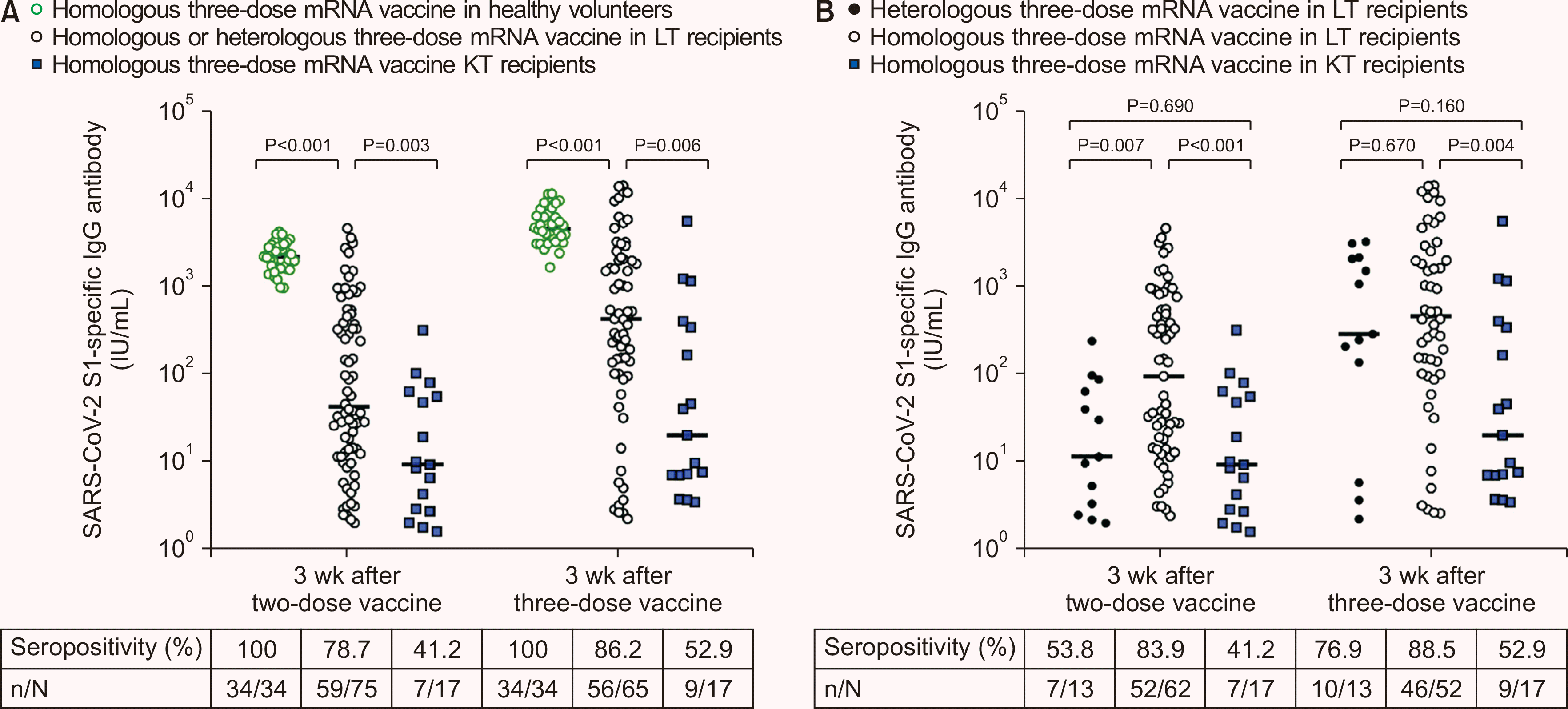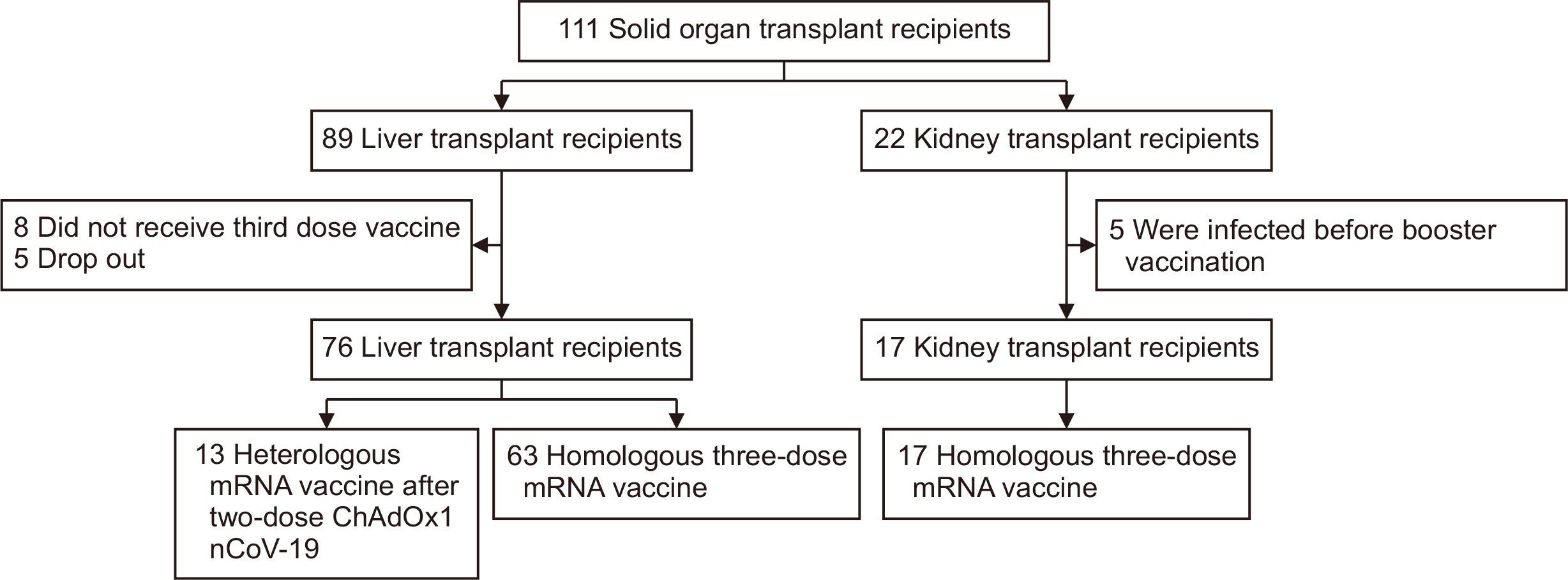1. Boyarsky BJ, Werbel WA, Avery RK, Tobian AA, Massie AB, Segev DL, et al. 2021; Antibody response to 2-dose SARS-CoV-2 mRNA vaccine series in solid organ transplant recipients. JAMA. 325:2204–6. DOI:
10.1001/jama.2021.7489. PMID:
33950155. PMCID:
PMC8100911.
2. Naylor KL, Kim SJ, Smith G, McArthur E, Kwong JC, Dixon SN, et al. 2022; Effectiveness of first, second, and third COVID-19 vaccine doses in solid organ transplant recipients: a population-based cohort study from Canada. Am J Transplant. 22:2228–36. DOI:
10.1111/ajt.17095. PMID:
35578576. PMCID:
PMC9347443.
3. Barda N, Dagan N, Cohen C, Hernán MA, Lipsitch M, Kohane IS, et al. 2021; Effectiveness of a third dose of the BNT162b2 mRNA COVID-19 vaccine for preventing severe outcomes in Israel: an observational study. Lancet. 398:2093–100. DOI:
10.1016/S0140-6736(21)02249-2. PMID:
34756184.
4. Tartof SY, Slezak JM, Fischer H, Hong V, Ackerson BK, Ranasinghe ON, et al. 2021; Effectiveness of mRNA BNT162b2 COVID-19 vaccine up to 6 months in a large integrated health system in the USA: a retrospective cohort study. Lancet. 398:1407–16. DOI:
10.1016/S0140-6736(21)02183-8. PMID:
34619098.
7. Benotmane I, Gautier-Vargas G, Cognard N, Olagne J, Heibel F, Braun-Parvez L, et al. 2021; Low immunization rates among kidney transplant recipients who received 2 doses of the mRNA-1273 SARS-CoV-2 vaccine. Kidney Int. 99:1498–500. DOI:
10.1016/j.kint.2021.04.005. PMID:
33887315. PMCID:
PMC8055921.
8. Rozen-Zvi B, Yahav D, Agur T, Zingerman B, Ben-Zvi H, Atamna A, et al. 2021; Antibody response to SARS-CoV-2 mRNA vaccine among kidney transplant recipients: a prospective cohort study. Clin Microbiol Infect. 27:1173.e1–4. DOI:
10.1016/j.cmi.2021.04.028. PMID:
33957273. PMCID:
PMC8091803.
9. Cucchiari D, Egri N, Bodro M, Herrera S, Del Risco-Zevallos J, Casals-Urquiza J, et al. 2021; Cellular and humoral response after MRNA-1273 SARS-CoV-2 vaccine in kidney transplant recipients. Am J Transplant. 21:2727–39. DOI:
10.1111/ajt.16701. PMID:
34036720. PMCID:
PMC8222867.
10. Grupper A, Rabinowich L, Schwartz D, Schwartz IF, Ben-Yehoyada M, Shashar M, et al. 2021; Reduced humoral response to mRNA SARS-CoV-2 BNT162b2 vaccine in kidney transplant recipients without prior exposure to the virus. Am J Transplant. 21:2719–26. DOI:
10.1111/ajt.16615. PMID:
33866672. PMCID:
PMC8250589.
11. Nazaruk P, Monticolo M, Jędrzejczak AM, Krata N, Moszczuk B, Sańko-Resmer J, et al. 2021; Unexpectedly high efficacy of SARS-CoV-2 BNT162b2 vaccine in liver versus kidney transplant recipients-is it related to immunosuppression only? Vaccines (Basel). 9:1454. DOI:
10.3390/vaccines9121454. PMID:
34960200. PMCID:
PMC8703477.
12. Lim SY, Yoon YI, Kim JY, Tak E, Song GW, Kim SH, et al. 2022; Antibody response induced by two doses of ChAdOx1 nCoV-19, mRNA-1273, or BNT162b2 in liver transplant recipients. Immune Netw. 22:e24. DOI:
10.4110/in.2022.22.e24. PMID:
35799703. PMCID:
PMC9250869.
13. Karnell JL, Karnell FG 3rd, Stephens GL, Rajan B, Morehouse C, Li Y, et al. 2011; Mycophenolic acid differentially impacts B cell function depending on the stage of differentiation. J Immunol. 187:3603–12. DOI:
10.4049/jimmunol.1003319. PMID:
21873529. PMCID:
PMC4180087.
14. Rabinowich L, Grupper A, Baruch R, Ben-Yehoyada M, Halperin T, Turner D, et al. 2021; Low immunogenicity to SARS-CoV-2 vaccination among liver transplant recipients. J Hepatol. 75:435–8. DOI:
10.1016/j.jhep.2021.04.020. PMID:
33892006. PMCID:
PMC8058047.
15. Meunier L, Sanavio M, Dumortier J, Meszaros M, Faure S, Ursic Bedoya J, et al. 2022; Mycophenolate mofetil decreases humoral responses to three doses of SARS-CoV-2 vaccine in liver transplant recipients. Liver Int. 42:1872–8. DOI:
10.1111/liv.15258. PMID:
35338550. PMCID:
PMC9115190.
16. Sanders JF, Bemelman FJ, Messchendorp AL, Baan CC, van Baarle D, van Binnendijk R, et al. 2022; The RECOVAC immune-response study: the immunogenicity, tolerability, and safety of COVID-19 vaccination in patients with chronic kidney disease, on dialysis, or living with a kidney transplant. Transplantation. 106:821–34. DOI:
10.1097/TP.0000000000003983. PMID:
34753894. PMCID:
PMC8942603.
17. Macedo C, Hadi K, Walters J, Elinoff B, Marrari M, Zeevi A, et al. 2018; Impact of induction therapy on circulating T follicular helper cells and subsequent donor-specific antibody formation after kidney transplant. Kidney Int Rep. 4:455–69. DOI:
10.1016/j.ekir.2018.11.020. PMID:
30899873. PMCID:
PMC6409398.





 PDF
PDF Citation
Citation Print
Print




 XML Download
XML Download